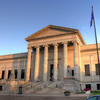More about The Birthday Party
- All
- Info
- Shop

Sr. Contributor
John Singer Sargent’s The Birthday Party captures the birthday celebration of the eldest son of his fellow artist friends, Albert Besnard and Charlotte Dubray Besnard.
Sargent was known for his formal portraits for which he received many commissions, but his true passion laid in his more experimental works. This painting is halfway between a genre scene and portrait, as he captures a moment in the Besnard family life, but gives a sense of the interiority of the subjects through their surroundings and relationships with each other in their gestures and posture.
The mother is the dominant figure in this painting, while the father is virtually faceless. It is a show of Charlotte Dubray Besnard’s maternal qualities–she is placed at the center of the painting with her mothering on display. Her rounded figure gives her a maternal presence, which could’ve been Sargent’s way of capturing the fact that she was with child–through pregnancy boobs. In comparison, Albert Besnard’s face is obscured, virtually faceless.
Sargent was known for his technique rather than color, his style often drawing comparisons to Velazquez. His brushwork is loose and painterly, not unlike that of Impressionism, which was the vogue of the day. Like the Impressionists, his ambition was to paint things the way they looked, focusing on how they appeared to the eye rather than their actuality, like the Realists. However, his paintings didn’t seek to capture light and movement in the way that Impressionists sought, rather focusing on capturing an impression of a scene, he tends towards a Velazquez-esque naturalism. His approach is encapsulated in his denial of his digression as an artist, saying of his portraits, “I do not judge, I only chronicle.”
Robert Besnard, the boy whose birthday is being celebrated, was himself an artist. Hailing from a family of artists (all of his siblings became artists as well), he also married a fellow artist, Lita Besnard. Art was central to the life of the Besnards, and Sargent’s gift is emblematic of its role. His life was well-documented through his parents’ work, mostly in paintings and sketches, and, of course, through his own. However, this painting gives a unique perspective of the family from the careful introspection of an outsider instead of through a paternal or personal lens.
The loose brushwork forming the candles on the cake makes the quantity unclear, although it is accepted as six, dating the painting in 1887 to match Robert’s age. It may also have been added by the Besnards after it was gifted to them by Sargent or that the scene was imagined by Sargent and presented to them as a birthday present when he visited Paris during Robert’s birthday. Robert died at age 33, a casualty of trench warfare, and his death made the painting even more valuable to Albert Besnard who said “the picture represents a Feast Day Cake which my wife is about to cut to the great joy of our little Robert, whose birthday it was. I can be seen standing at the back of the picture participating in this family feast. What a precious souvenir for his mother and for me!” about the piece.
Through the references he fills his paintings with combined with the unique poses of his sitters and the vigorous color, it is perhaps in the personal portraits that Sargent paints that was his genius. In his derivative style, he is able to capture the personality of his sitters and with grandeur reminiscent of his formal portraits, but in a way that still feels identifiable to the modern viewer.
Sources
- Blashfield, Edwin H. "John Singer Sargent: Recollections." The North American Review 221, no. 827 (1925): 641-53. www.jstor.org/stable/25113428.
- Bodkin, Thomas. “John Singer Sargent.” An Irish Quarterly Review, Vol. 17, No. 66 (Jun., 1928), 257-265. Messenger Publications. https://www.jstor.org/stable/30094327.
- Cotter, Holland. “Review: Sargent’s Intimate Portraits of Friends at the Metropolitan Museum.” New York Times. July 2, 2015. https://www.nytimes.com/2015/07/03/arts/design/review-sargents-intimate….
- Mahon, Dorothy, and Silvia Centeno. "A Technical Study of John Singer Sargent's Portrait of Madame Pierre Gautreau." Metropolitan Museum Journal 40 (2005): 121-15. Accessed February 2, 2020. www.jstor.org/stable/20320648.
- McGarry, Rachel. “Boyhood: Watch John Sargent Singer’s ‘birthday boy’ grow up.” Minneapolis Institute of Art. December 20, 2016. https://new.artsmia.org/stories/boyhood-john-singer-sargents-birthday-b….
- Shone, Richard. "John Singer Sargent and the Edwardian Age." The Burlington Magazine 121, no. 917 (1979): 532-36. Accessed February 2, 2020. www.jstor.org/stable/879628.
- “The Birthday Party.” Artsmia. Accessed February 5, 2020. https://collections.artsmia.org/art/1509/the-birthday-party-john-singer….
- “The Birthday Party (Fete Familiale).” The Met Museum. Accessed February 5, 2020. https://www.metmuseum.org/art/collection/search/21399.












